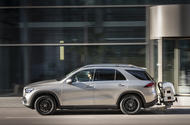Real-world data from EU-mandated in-car tech has highlighted shortcomings in testing
The car industry is facing a possible crisis concerning real-world fuel economy data – which could have wide-ranging repercussions as significant as the fallout from the Dieselgate emissions test cheating scandal.
Two reports have emerged from the European Union over the past few weeks, the latest from the European Commission, and both could have far-reaching effects on the type of vehicles that manufacturers will be selling as soon as 2026.
What has happened?
The European Court of Auditors and the European Commission both say the first real-world data obtained on fuel consumption shows that petrol, diesel and plug-in hybrid cars are all well adrift of their official laboratory calculated fuel consumption and CO2 emission figures.
The first estimates for a sample of cars registered in 2022 show that the WLTP test regime overestimates the fuel economy of petrol cars by 23.7% and of diesel cars by 18.1%.
PHEVs average CO2 emissions of 139.5g/km, which is some 23% better than the internal combustion engine average.
However, the real-world monitoring suggests that PHEVs aren’t being charged as often as was estimated by the WLTP regime.
The upshot of the analysis is that larger-engined models, the heaviest SUVs and luxury cars and PHEVs, along with underperforming mainstream ICE vehicles, will now face renewed scrutiny by the European authorities.
The EU Court of Auditors also recommends that the EU follows the UK’s legislative lead and drops the current laws that make car makers meet ‘fleet average’ CO2 targets (currently 115.1g/km, dropping to 93.6g/km from next year) in favour of “targets based instead on a minimum share of zero-emission vehicles”.
Although the UK market is no longer directly affected by EU CO2 fleet average laws, 53% of cars made in the UK are exported to the EU market, so British car makers’ offerings will remain under scrutiny.
What went wrong?
After Dieselgate, the EU moved to replace the standardised New European Driving Cycle (NEDC) laboratory fuel economy tests, which dated back to 1992, with a new economy test format.
The Worldwide Harmonised Light Vehicles Test Procedure (WLTP) then arrived in 2017. The WLTP test cycle was longer (30 minutes instead of 20 minutes), conducted over a greater distance (14 miles instead of six miles), included less stopping, took in higher average speeds and required greater levels of acceleration.
Assurances were given that the WLTP driving cycle “was based on a global statistical survey of real driving profiles”, but new in-car technology quietly deployed by the EU in new cars since 2021 has now proved the test to be significantly overestimating cars’ real-world economy.
It wasn’t widely discussed, but the EU legislated for the installation of on-board fuel consumption monitoring devices (OBFCMs) in vehicles sold in member states.
These had to be fitted to cars registered from 2021 and in vans registered from 2022. The European Commission said: “Regulation EU 2019/631 also tasked the Commission with monitoring the ‘realworld’ CO2 emissions of vehicles on the road, using the data read out from the OBFCM devices and comparing it with the corresponding official WLTP data.”
Now the first results of this real-world monitoring have thrown the EU’s fleet CO2 targets into doubt.
What happens now?
With the exception of its reaction to the real-world charging patterns for PHEVs (it will change the way their CO2 emissions are calculated next year), the Commission’s report was relatively mild in tone.
It said the initial data wasn’t yet “broad or representative enough to draw firm conclusions” but did express concern about the predominance of heavy SUVs and luxury vehicles, which stray even further from the WLTP results than mainstream cars.
However, a parallel report from the European Court of Auditors was harder-hitting. It admonished the European Commission and member states for not submitting realworld CO2 data in time, and wasn’t interested in simply refining current legislation for descending fleet CO2 targets.
Firstly, it said: “The key challenge for meeting emission-reduction targets for 2030 and beyond will be to ensure a sufficient uptake of zero-emission vehicles.
In particular, it will be important to address electric vehicle affordability, provide sufficient electric vehicle charging infrastructure and secure the supply of raw materials to produce batteries.”
Secondly, and more radically, the Court of Auditors wants the European Commission to tear up today’s emissions legislation by 2026.
It said: “The Commission should assess the feasibility, costs and benefits of the following changes to the [current] CO2 regulation, replacing the current EU and manufacturer-level targets with targets based instead on a minimum share of zero emission vehicles”.
Such a move would mirror the policy on car sales that the UK adopted after Brexit. Furthermore, the Court of Auditors wants to see a “real-world emissions cap at manufacturer level, one that should not be exceeded for combustion-engine cars and including all types of hybrid”.
This demand will put all nonelectric cars in the spotlight. Reading between the lines, it could easily mean that the sale of larger-engined vehicles, and heavier vehicles such as SUVs and luxury cars, could be throttled back.
It’s possible that the Court of Auditors has seen the detail in the EU document that suggests buyers are opting for the more highly specced and therefore heavier and more consumptive versions of ICE cars.
However these reports shake out, it looks like the car industry is set for another earthquake in Europe.







